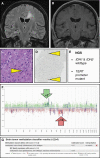The cIMPACT-NOW updates and their significance to current neuro-oncology practice
- PMID: 33664964
- PMCID: PMC7906262
- DOI: 10.1093/nop/npaa055
The cIMPACT-NOW updates and their significance to current neuro-oncology practice
Abstract
Over the past 4 years, advances in molecular pathology have enhanced our understanding of CNS tumors, providing new elements to refine their classification and improve the 2016 World Health Organization (WHO) Classification of CNS tumors. The Consortium to Inform Molecular and Practical Approaches to CNS Tumor Taxonomy-Not Official WHO (cIMPACT-NOW) was formed in late 2016 by a group of neuropathology and neuro-oncology experts to provide practical recommendations (published as cIMPACT-NOW updates) to improve the diagnosis and classification of CNS tumors, in advance of the publication of a new WHO Classification of CNS tumors. Here we review the content of all the available cIMPACT-NOW updates and discuss the implications of each update for the diagnosis and management of patients with CNS tumors.
Keywords: IDH-mutant gliomas; brain tumor classification; cIMPACT-NOW; glioblastoma; molecular pathology.
© The Author(s) 2020. Published by Oxford University Press on behalf of the Society for Neuro-Oncology and the European Association of Neuro-Oncology. All rights reserved. For permissions, please e-mail: journals.permissions@oup.com.
Figures




References
-
- Louis DN, Ohgaki H, Wiestler OD, et al. . World Health Organization Classification of Tumours of the Central Nervous System. 4th ed. Louis DN, Ohgaki H, Wiestler OD, Cavenee WK, eds. Lyon: International Agency for Research on Cancer; 2016.
-
- Louis DN, Perry A, Reifenberger G, et al. . The 2016 World Health Organization Classification of Tumors of the Central Nervous System: a summary. Acta Neuropathol. 2016;131(6):803–820. - PubMed
-
- Louis DN, Aldape K, Brat DJ, et al. . Announcing cIMPACT-NOW: the Consortium to inform molecular and practical approaches to CNS tumor taxonomy. Acta Neuropathol. 2017;133(1):1–3. - PubMed
-
- Louis DN, Wesseling P, Paulus W, et al. . cIMPACT-NOW update 1: not otherwise specified (NOS) and not elsewhere classified (NEC). Acta Neuropathol. 2018;135(3):481–484. - PubMed
Publication types
LinkOut - more resources
Full Text Sources
Miscellaneous

